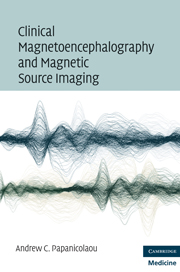Book contents
- Frontmatter
- Contents
- Contributors
- Preface
- Section 1 The method
- 1 Basic concepts
- 2 The nature and origin of magnetic signals
- 3 Recording the magnetic flux
- 4 Overview of MSI using the single equivalent current dipole (ECD) model as an example
- 5 The fundamental problems of MSI
- 6 Head models
- 7 Source models – discrete source models
- 8 Source models – distributed source models
- 9 Source models – beamformers
- 10 Pragmatic features of the clinical use of MEG/MSI
- Section 2 Spontaneous brain activity
- Section 3 Evoked magnetic fields
- Postscript: Future applications of clinical MEG
- References
- Index
8 - Source models – distributed source models
from Section 1 - The method
Published online by Cambridge University Press: 01 March 2010
- Frontmatter
- Contents
- Contributors
- Preface
- Section 1 The method
- 1 Basic concepts
- 2 The nature and origin of magnetic signals
- 3 Recording the magnetic flux
- 4 Overview of MSI using the single equivalent current dipole (ECD) model as an example
- 5 The fundamental problems of MSI
- 6 Head models
- 7 Source models – discrete source models
- 8 Source models – distributed source models
- 9 Source models – beamformers
- 10 Pragmatic features of the clinical use of MEG/MSI
- Section 2 Spontaneous brain activity
- Section 3 Evoked magnetic fields
- Postscript: Future applications of clinical MEG
- References
- Index
Summary
Distributed source models
The single ECD model remains the principal one used for clinical applications. However, a number of other models that are used mostly for basic research may eventually be adopted by the clinical research community and improve the diagnostic utility of the ECD.
In distributed source models, the entire brain or just the cortex is divided into a large number of elements that form the “solution space.” Triangular lattices are generally used to represent the cortical surface, while tetrahedral or hexahedral lattices are used to represent the interior of the head, such as the cortical volume. Typical lattice spacings range from 1 mm to 1 cm. Each lattice point may represent a single dipole, or a two-compartment volume (sphere model) or three-compartment volume (realistic model) of dipoles.
Mathematically, these models represent ill-posed or underdetermined problems, because the number of observation points – the MEG recording sensors – (usually a few hundred) is much less than the number of source coefficients that must be identified (usually several thousand). Thus, when solving the inverse problem (during which a cost function representing the error between estimated and measured fields is minimized) to obtain a useful estimate for the sources, the cost function must be augmented with an additional constraint so that the minimization algorithm can select the “best” current distribution among those capable of explaining the data.
Minimum-norm models
Minimum-norm models constitute a subtype of distributed source models that attempts to account for the measured magnetic field at a single time point by finding the “smallest” distribution of dipoles that can account for the data.
- Type
- Chapter
- Information
- Publisher: Cambridge University PressPrint publication year: 2009



